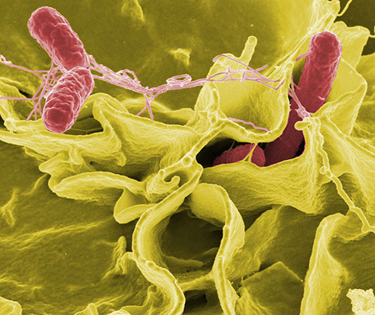Introduction: The Nature of Science and Physics
6 Problems and Exercises
Problems & Exercises
- How many heartbeats are there in a lifetime?
- A generation is about one-third of a lifetime. Approximately how many generations have passed since the year 0 AD?
- How many times longer than the mean life of an extremely unstable atomic nucleus is the lifetime of a human? (Hint: The lifetime of an unstable atomic nucleus is on the order of [latex]{\text{10}}^{-\text{22}}\text{ s}[/latex].)
- Calculate the approximate number of atoms in a bacterium. Assume that the average mass of an atom in the bacterium is ten times the mass of a hydrogen atom. (Hint: The mass of a hydrogen atom is on the order of [latex]{\text{10}}^{-\text{27}}\text{ kg}[/latex] and the mass of a bacterium is on the order of [latex]{\text{10}}^{-\text{15}}\text{ kg.}[/latex])

Figure 5.2: This color-enhanced photo shows Salmonella typhimurium (red) attacking human cells. These bacteria are commonly known for causing foodborne illness. Can you estimate the number of atoms in each bacterium? (credit: Rocky Mountain Laboratories, NIAID, NIH) - Approximately how many atoms thick is a cell membrane, assuming all atoms there average about twice the size of a hydrogen atom?
- (a) What fraction of Earth’s diameter is the greatest ocean depth? (b) The greatest mountain height?
- (a) Calculate the number of cells in a hummingbird assuming the mass of an average cell is ten times the mass of a bacterium. (b) Making the same assumption, how many cells are there in a human?
- Assuming one nerve impulse must end before another can begin, what is the maximum firing rate of a nerve in impulses per second?

